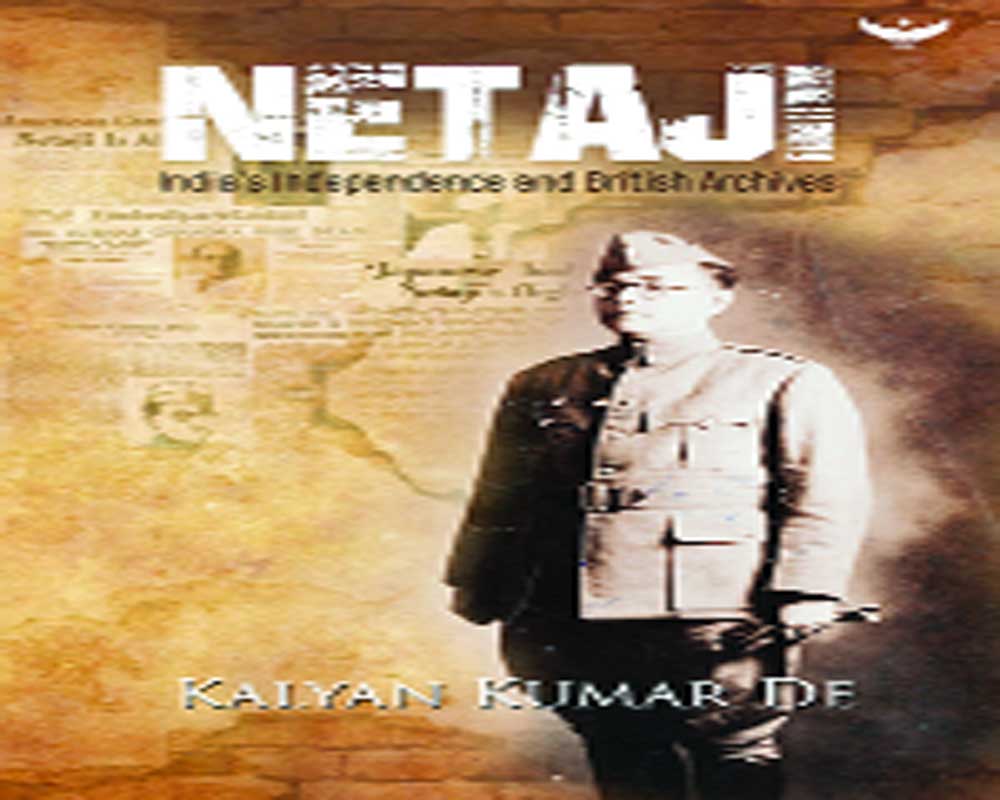Book Name: NETAJI — India’s Independence and British Archives
Author: Kalyan Kumar De
Publisher: Garuda Prakashan, Rs 299
Kalyan Kumar De’s book Netaji — India’s Independence and British Archives, puts to rest a lot of myths that appear to have surfaced in the last few decades, writes PRASHANT PANDEY
In 1942, after the Quit India Movement was launched and almost immediately crushed by the British, things were moving at quite a pace. The World War-II (WW-II) was going on.
On the other hand, Netaji Subhash Chandra Bose had escaped from India in 1941 and formed the Indian National Army (INA), in 1943, which allied with Japan and intended to enter India from its far-eastern side against the British and defeat them. With America dropping the two atom bombs on Japan, forcing it to surrender, the WW-II ended in August, 1945. In the same month, Netaji was said to have been killed in a plane crash.
Nearly 45,000 INA soldiers were taken prisoners-of-war and the trials ensued in Red Fort; while almost 30,000 had laid their lives during the war. The political leadership in the country was listless. But by November 1945, something was happening within India, which had made the British jittery. It was not a mere concern. For instance, the mighty British Empire, which had, as a matter of policy arising out of practical feasibility, stopped bringing in British troops to control this vast land, was now thinking of rushing in “British reinforcements”. The Indian troops, suddenly, were not reliable. The sympathy wave in favour of INA also gave in the hands of a deflated Congress, and even Muslim League (which was busy furthering its communal agenda), an election campaign issue to whip up sentiment in its favour. Ultimately, the British had to dispense away with capital punishment to top three INA officers, Shah Nawaz Khan, Gurbaksh Singh Dhillon and Prem Sehgal. Finally, they decided to free India in, as early as, March 1946 — a secret that only the British knew. This background could well have been dismissed as yet another ‘story’ around Bose and INA on the ground of alleged ‘lack of primary evidence’.
In the past few years, several books — primarily by Anuj Dhar (Netaji: Back from Dead; India’s Biggest Cover-up and others), Kingshuk Nag (Netaji: Living Dangerously); and Maj Gen (retd) G D Bakshi (Bose — an Indian Samurai) have not only kept the Bose and INA story alive, but have painstakingly proved the myths around Netaji; particularly his death in a plane crash on August 18, 1945.
However, the real impact of Bose and INA on India’s independence; particularly against the ubiquitous narrative of “De Dee Humein Azadi Bina Khadg, Bina Dhaal...”, still appeared to be a non-starter. There was debate, but none of the sides had enough to settle it. But no longer!
Netaji: India’s Independence and British Archives by Kalyan Kumar De fills that long-felt gap between the legend of Bose and INA and the truth. Prior to this, Atlee accepting before the then Chief Justice of Calcutta High Court in 1956 that Gandhi’s role was “m-i-n-i-m-a-l” and it was Bose and INA, which forced them to quit, was among some of the things available to us. But, it was not on strong wicket as, indeed, it was tertiary evidence.
It is for the first time that we have direct evidence from the British archives. These “Transfer of Power” documents were de-classified by the British in 1971. That nobody bothered to look at them all these years is a testimony to our callous attitude towards our own history.
They are records — in the forms of letters, reports and minutes — of correspondences taking place between the people who mattered. How many of us have heard of Lord Viscount Wavell? Or General Auchinleck (the then head of the British Indian Army)? Or Lord Pethick-Lawrence (the then Secretary of State for India in London)? Of course there was the then PM Atlee. Interestingly, these exchanges appear to have taken place, and a decision arrived at within five-odd months — November 1945 and March 1946.
In fact, reading through these letters, the reader would be led to two more things, apart from concluding about Bose and INA’s role in India’s independence. One, the letters provide an insight as to how it was the military, which helped the British control this country, while seemingly engaging with the ‘civil-political leadership’. Two, Nehru and Jinnah, the British thought, were interested in playing their own game. In those times, Netaji had become a rather sharp emotive issue; more so, when it came to Netaji-vs-Bapu/Nehru debate. Biases crept in fast and stands were taken in a jiffy. In such a scenario, the author has done a great service to the truth by doing two things — a) Quoting the letters, reports and minutes verbatim, and, in full; b) Refraining from giving his own interpretations.
It is akin to author inviting the readers to the British archives and dishing out paper-after-paper for the readers’ perusal, leaving it up to them to conclude.
The documents can’t be dismissed because they are official; Written by the British for their own consumption, carried out in top secret; and they are by and between people who mattered. That we as a nation after even nearly 75 years of independence are sparring over ‘who got us independence’ is, actually, a sad story. The celebration and veneration of all in the entire pantheon of national leaders should not have been turned into a demoralising fight for credit.
But then, one person, one family and, by proxy, one party had to stay politically afloat in post-independent India — basking in the reflected glory of their benefactor. This book, though small, should put paid to all the myth-making in the last few decades. In short, it is safe to call it a “handbook of truth”.
The reviewer is a former journalist with interests in society, history, politics, culture, films, and cricket


























